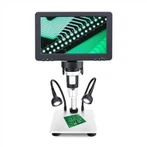Method steps for cleaning a microscope
The cleaning of precision optical devices may reduce the performance of the device, and improper or unnecessary cleaning can easily damage the surface coating of the device. Proper handling and storage of devices in dedicated containers will minimize cleaning and damage to the device.
A. Recommended cleaning materials · Polyethylene laboratory gloves · Optical grade lens cleaning paper · Degreasing long-staple cotton · Mix alcohol and ether solutions in proportion according to the environment to clean the surface of optical parts.
The recommended proportions are as follows: a Room temperature: 18 ℃-24 ℃ Ethanol: 35% Ethyl ether: 65% b Room temperature: 12 ℃-18 ℃ Ethanol: 25% Ethyl ether: 75%
B. Recommended cleaning procedures
1. Blow off the floating dust on the surface with clean air. If it cannot be blown clean, take two pieces of lens tissue and wrap them on a cotton swab or fold the lens tissue slightly larger than the area to be cleaned.
2. When wiping the surface of optical parts, first use petroleum ether to clean the matte surface and frame.
3. When wiping round parts, the cotton ball should move in a spiral from the center to the edge. At the same time, the cotton ball should also rotate, and move the cotton ball out of the lens surface. Do not stay on the edge of the lens to avoid leaving marks. If you use When wiping with a gyrator, when wiping, the cotton ball should move in a straight line from the center to the edge, and the cotton ball itself rotates at the same time (the amount of rotation of the cotton ball should be slightly less than one week).
4. When wiping the prism, place the cotton ball horizontally on the surface to be wiped and wipe it in a straight line.
5. It should be wiped in a relatively clean room and wiped with long-staple cotton. The cleaning solution contained in the cotton ball should not be too much. Wipe off the filler layer.
6. When wiping the glued optical parts, the cotton ball should not be dipped in the mixture too much, so as to avoid the solvent from invading the glued layer and causing degumming.
7. For reflective parts with aluminum plating and protective film, if the protective film is relatively strong, it can be wiped with a cotton ball dipped in a little mixture or a carefully degreased emery cloth.
8. The cotton ball should be rolled well, and the head of the bamboo stick used to roll the cotton ball should not be exposed, so as not to scratch the parts. The size and shape of the cotton balls should vary with the size and type of the parts. Generally, cylindrical cotton balls are used for round parts, and flat cotton balls are used for flat parts. Except for soft cotton balls used on the coated surface (especially reflective magnesium), In other cases, the cotton ball should be rolled up tightly.
9. When the cotton ball dipped in the mixture penetrates into the solvent, please do not exceed one-third of the length of the cotton ball.
Notice:
·Before wiping, the operator should carefully wash his hands with detergent and dry them with a degreased towel.
·Operators should wipe and clean all the utensils in the room, and degrease the tools and fixtures that are in contact with optical parts.
·One cotton ball can only be used to wipe once, please do not dip the used cotton ball in solvent for reuse.
·Before cleaning optical devices, please remove rings and other jewelry from hands, wash hands carefully and wear gloves.
·During work, if your hands sweat or come into contact with grease, you need to re-wash your hands as required.
·Wipe the optical parts. If you must handle the polished surface of the optical parts with your hands, please degrease the gloves you are wearing.
·When wiping optical parts with frames, care should be taken not to allow dirt to adhere to the surroundings of the frame or fibers to hang on the frame, and for optical parts without frames to prevent dirt from adhering to the matte surface.






